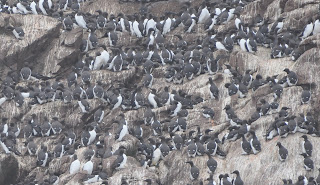Day 19
Miles 460 (5970)
Two Lanes 406 (4831) 81%
Top Down 299 (5385) 90%

So how do you pronounce the name of this province? Most of us were taught to put the accent on the first syllable and not to pronounce the ‘ou’ sound in the second syllable. (NEW-fund-land). But that is not how the locals say it. They pronounce it New-fund-LAND with the accent on the last syllable. A minor accent is on the first. There is almost a lilt at the end. This might be because this province has a large Irish population, and the name is said with a bit of an Irish accent. However you say it, don’t put the accent on the middle syllable, as many non-Newfoundland Canadians do. According to our guide on the puffin boat yesterday, that way is “clearly wrong!”
We left St. John’s on a rainy morning to drive across ”The Island,” as the locals call Newfoundland. Driving on Transcanada 1 from the east end, we headed to Rocky Harbour, 439 miles away. We have now been at the most western and most eastern termini of the “TCH”: Victoria, BC and St. John’s.
We passed the exit for (and you can’t make this stuff up): Dildo, Heart’s Desire, Heart’s Delight, and Heart’s Content. It must get lonely while those fishermen are at sea, but at the end is “Content”.
Next we passed the turn off for the ferry to St. Pierre and Miquelon Islands. Following the defeat of the French at the hands of the British in Quebec to end the Seven Years War (1763), the peace treaty left these two islands to France and the English took the rest. Later in 1803 the Louisiana Purchase gave the lands from the Mississippi to the Rockies to the US. So out of the vast amount of lands controlled by the French (eastern Canada and the Mississippi and Missouri Valleys) before 1763, all that is left today of French territory in North America are these two islands, located 16 miles off the Newfoundland coast and measuring in total 93 square miles of granite. St. Pierre Island is reported to still retain the wrought iron balconies and the flare of the French.
Then off to Gander, the last airport in North America before you cross the Atlantic. Gander has much history, some heroic, some tragic. It was important in World War II as a resupply base and as a base for anti-submarine air activities. On Sept. 11, 2001, when all US airspace was closed after the Twin Towers attacks, this little town played host to more than twice its population for several days. You can read more about this in my posting from last year, or by googling “Gander Operation Yellow Ribbon.”
But in December, 1985, 259 members of the famous US 101st Airborne Division died when their plane crashed upon take-off after refueling here. It is ironic and tragic that these highly trained and famous paratroopers died inside their plane, and not from their dangerous jumps into enemy lands.
Much of central Newfoundland is the same Canadian Shield we drove through in Ontario. Small rolling hills dotted with lakes and covered with birches and evergreens to a height of about twenty feet…..for miles. But every once in awhile, you cross a broad flat gravel bottomed creek. Stony Creek outside of Grand Falls, NL is one of those. Fishermen were parked by the bridge. Clifford was getting his tackle ready to go out into the river. He has been fishing Stony Creek his whole life. The salmon here run in June and July and into early August. The seasonal limit to keep is four. Otherwise it is catch and release.
The Canadians understand fisheries better than we do. We make you throw back he small ones. They make you throw back the big ones. Here is the thinking. The big ones are the hardy rootstock they are proven survivors. They have the genes you want in the gene pool. So in Newfoundland anything over 63.5 cm long (25 inches) must be released. You can catch the small ones and keep them, but nobody does, because these would count towards the limit. The largest one Clifford has caught and kept was 7 pounds and 62.9 cm. The largest one he ever caught (and had to release) was 10 pounds and 68 cm. Mr. Hurlburt……ready to fish?
We arrived at Rocky Harbour in Gros Morne National Park (an UNESCO site…more about it tomorrow) about 8:30 pm and checked into our private cabin with a view of the sea. The sun was still high in the sky and would not set for another hour. I love summer in the Northland. Dusk at 10 pm is perfect.
I don’t normally talk about our dinners. But we bought fresh Atlantic salmon caught and packed today! We cooked it in the garlic olive oil that we have carried for 5900 miles. It was a gift from Pat Ransdell. That, along with a wild rice pilaf and salad, were the perfect preliminaries for the aptly named “Death by Chocolate” ice cream that Linda bought made by a Nova Scotia dairy (and shipped over here by ferry, like everything else not caught or made here.) Then we settled down to a card game played with the Jumbo sized cards for the hard of sight given to us by our nephew Bob!
The colored homes of St. John's

The central plateau of Newfoundland

Stony Creek

Clifford

250 miles from Rocky Harbour on the road north is where the Vikings first landed in America in about 1000 A.D. Vikings are also thought to have visited the Rocky Harbour area.

The road into Gros Morne

Sunset from our cabin


Our dinner, caught today, cooked by us in our cabin.






















































